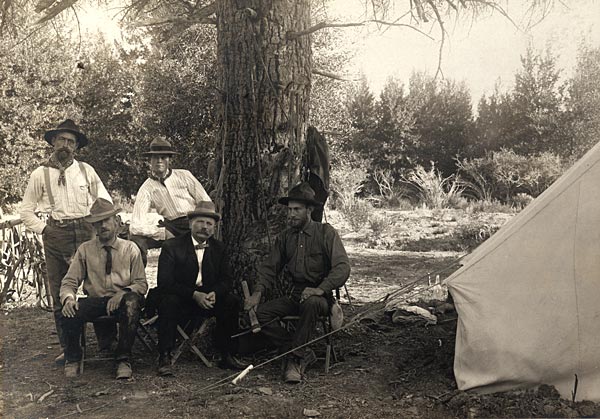|

1904 Eocene of Wyoming
Encourged by the exteremely productive 1903 season, a second year of collecting in the Bridger Basin was undertaken. The party consisted of Mr. Walter Granger, in charge, Mr. Paul Miller, assistant from the museum, who remained with the party for the entire season, Dr. W. D. Matthew, who joined the party at Henry's Fork about Aug. 15th and remained until the last of September, Mr. C. S. Mead, a volunteer form Ohio State University, who joined the party at the beginning and stayed until August 20th and Mr. George Olsen of Laramie, cook and teamster. Mr. Granger and Mr. Miller left the museum late in May reaching Fort Bridger on the 28th where they were joined by Mr. Mead and a few days later by Mr. Olsen, who had driven the Bone Cabin Quarry team with a light buckboard from Medicine Bow. Camp was established June 3rd on Cottonwood Creek about half a mile below the stage road. There are considerable exposures here, but were rather barren aside from a good skull and jaws of Palaeosyops. About ten days were spent here and the outfit was moved southward along the "horse ranch trail" to Summer's Dry Creek, where four days were spent prospecting. A good skull of Hyrachyus and some skeletal material of Pantolestes was found. The scarcity of good water forced the party to move to Cat-tail Springs, seven miles eastward along the base of Henry's Fork Table. From this camp and the following one at the mouth of the Cat-tail Springs draw a layer was examined that included the middle and uppermost section of the beds and was fairly good collecting. On July 3rd the party reached Spanish John's Meadow and the following day camp was established at the big spring near the top of Twin Buttes. The bad-lands reached by this camp were disappointing. About 2 weeks were spent at this place, then the party returned to Spanish John's Meadow. A day was spent examining a rather small pocket which yielded some Uintatherium bones. Six miles south a half day search was made at Lane Meadow, which was fruitless. The party proceeded to Henry's Fork and made camp at Bullock's Ranch, about 3 miles above Burnt Fork Post Office. The Henry's Fork exposures proved to be the richest encountered during the trip and the remainder of the summer was spent there. About a month was spent at Bullock Ranch, another month at the old stamping grounds near Summer's Ranch and the remainder of the season at Burnt Fork Post Office and Lane Meadow. At several points 3 calcareous layers were discovered, which were especially rich in small forms, such as primates, rodents and Hyopsodus. The most notable of these layers was one found by Miller opposite Burnt Fork Post Office, which yielded over 100 jaw fragments in one days collecting. In the fall of 1903 Granger learned of a Uintatherium specimen discovered by a brother of Mr. Thomas Widdap of Burnt Fork. Prof. Knight of the University of Wyoming had seen it and agreed to purchase it. Due to Prof. Knight's death, Mr. Widdap agreed to sell the prospect to the AMNH. The prospect was located about a mile south of Lane Meadow and 2 weeks were spent in the excavation. It proved to be about 1/3rd a skeleton in splendid condition and included many vertebrae and ribs. A fine pair of lower jaws of Patriofelis was nearby. The party was disbanded on Oct. 12th at Fort Bridger. The collection comprising 15 boxes was shipped from Carter. The field record shows that 281 specimens were collected.
|